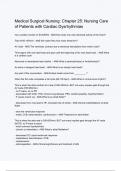Exam (elaborations)
Medical Surgical Nursing_ Chapter 25_ Nursing Care of Patients with Cardiac Dysrhythmias (1
- Course
- B260 Infection Control
- Institution
- B260 Infection Control
Medical Surgical Nursing_ Chapter 25_ Nursing Care of Patients with Cardiac Dysrhythmias (1
[Show more]



